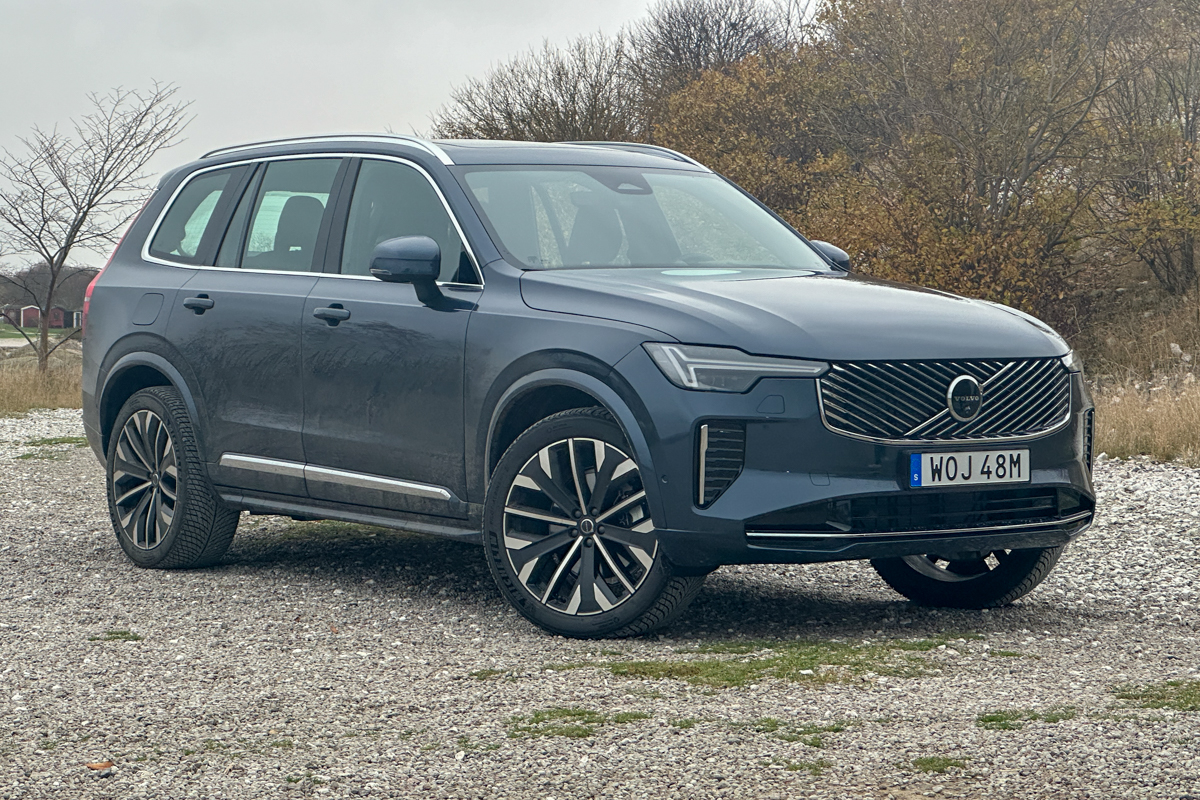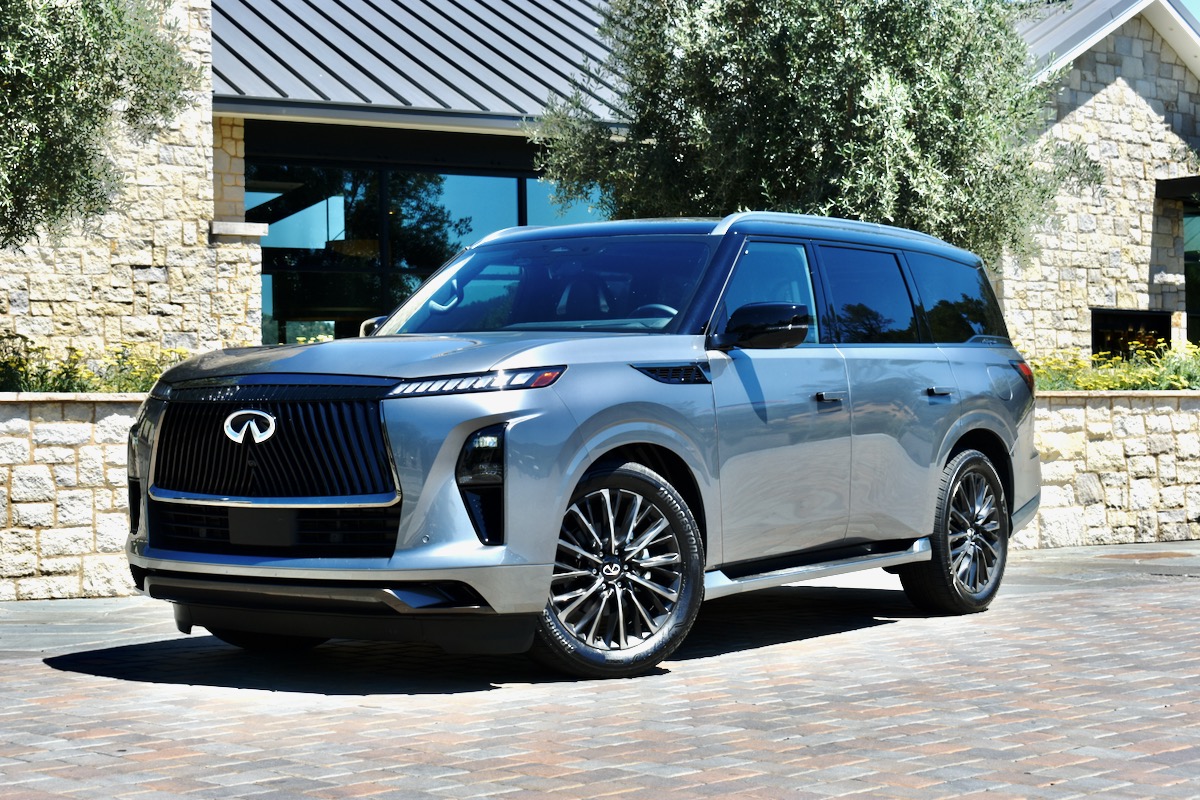Born as a cost-effective luxury SUV competitor to the Lincoln Navigator and the Cadillac Escalade, the Infiniti QX80 has evolved significantly over its three generations. While premium amenities were always standard, the QX80 now offers a high level of tech, even with base models, with plenty more as you climb the trim levels. What was once a segment of three now includes the original, full-size, body-on-frame SUVs, along with bougie unibody competitors such as the BMW X7, the Land Rover Range Rover, the Mercedes-Benz GLS, and the body-on-frame Lexus LX.
While the Infiniti QX80 has shared a lot with the Nissan Armada throughout the years—and still does—the premium materials and extra tech features, such as the biometric cooling system and the driver-focused individual audio system—help better set it apart than previous generations.
While some will lament the loss of the V8 engine in the latest version, the new twin-turbo V6 offers 50 more horsepower, along with a small increase in fuel economy.
Infiniti has always placed an emphasis on safety features and tech, so it makes sense that it won the Top Safety Pick+ Award its first time out of the gate. The National Highway Traffic Safety Administration gave it an overall four-star rating starting in 2019, although the 2025 model hadn’t been rated at the time of writing. Our buyer’s guide tells you what you need to know about buying a new or a used QX80.
Infiniti QX80: Cost, Reliability, and the Best Years to Buy
- Frequently Asked Questions
- Infiniti QX80 Pros and Cons
- Infiniti QX80 Generations
- Infiniti QX80 Third Generation (2025–present)
- Infiniti QX80 Second Generation (2011–2024)
- Infiniti QX80 First Generation (2004–2010)
Frequently Asked Questions
Which Infiniti QX80 years are the best?
The Infiniti QX80 has been fairly problem free according to CarComplaints.com, and skimming through recalls and complaints on NHTSA.gov shows similar results. In fact, since 2020, the QX80 has had only three recalls, one in 2020 and two in 2021. Looking at 2022 and 2023, the last two years of the previous generation, there were no recalls or investigations, so they’re definitely the years to look for if you’re after a relatively new example.
What are the worst Infiniti QX80 years?
Though the QX has been remarkably free of recalls and complaints, there some years to avoid. CarComplaints.com calls 2005 the worst model year, because of high repair costs and more problems at lower mileages. It’s worth pointing out that the 2011 model year had the most complaints, many of which relate to peeling paint. In the second generation, CarComplaints.com dubbed 2014 the worst model year due to electrical problems, but the 2019 logged the most overall complaints for battery drain.
Is a used Infiniti QX80 a good deal?
A used Infiniti QX80 is a pretty good deal considering that the national average purchase price for 2022 models—vehicles that are just likely coming off lease—is about 50% off the original MSRP. That gets you modern amenities such as wireless Apple CarPlay and a large 12.3-inch infotainment screen, plus the likes of heated front seats, a heated steering wheel, leather seats, remote start, a power moonroof, a tri-zone, climate control system, and 20-inch wheels for a relatively affordable sum.
Infiniti QX80 Pros and Cons
Pros:
- Powerful engines
- Plenty of cargo space
- Impressive audio system
Cons:
- Small third row
- Bad fuel economy
- Poor ride quality
Infiniti QX80 Generations
Infiniti QX80 Third Generation (2025–present)
The new QX80 got a swish redesign for the 2025 model year, and the most notable change is that the V8 powertrain was ditched after two decades. In its place was a more powerful 3.5-liter twin-turbo V6 that delivered 450 horsepower and 516 lb-ft of torque, running through a nine-speed automatic transmission. The maximum towing capacity was still 8,500 pounds and it was available with standard rear-wheel drive (RWD) or with a full-on four-wheel drive (4WD) drivetrain rather than AWD—although it doesn’t scream “off-road” when you look at it.
While previous generations represented the affordable luxury option in the class, the third generation went decidedly upmarket in design and in price. It grew about an inch in length and three inches in width, and heralded a bold, curvaceous design. The big grille crept up onto the hood via an all-new trim piece, and there was a new stacked headlight setup. At the back, the taillights were full-width and comprised more than 300 LEDs.
At launch, the new Infiniti QX80 had four trim levels: QX80 Pure, QX80 Luxe, QX80 Sensory trim, and QX80 Autograph. It offered seating for seven or eight in all but the top Infiniti QX80 Autograph trim, which only seated seven. Standard specs included a dual-screen 14.3-inch gauge cluster/infotainment touchscreen display, Infiniti InTouch with a Google built-in operating system, a 14-speaker Klipsch premium audio system, wireless Apple CarPlay and Android Auto functionality, leather-appointed seating, and the hands-on ProPilot Assist 1.1 system that included steering assist and adaptive cruise control.
Standard driver assistance features included automatic emergency braking with pedestrian detection, predictive forward collision warning, blind spot monitoring, rear cross-traffic alert, blind spot intervention, and lane departure prevention.
With an emphasis on advanced technology, the third-generation QX80 included an in-car camera, electronic air suspension and dynamic digital suspension, wide front-view camera angles, a head-up display, an invisible hood view camera angle, massaging front and second-row seats, a camera in the rearview mirror, heated third-row seats, a front console cool box, and a 64-color personalized ambient lighting system.
It also touted innovative tech such as biometric cooling that used an infrared sensor to detect when a passenger was hot and automatically adjusted the temperature and air flow. Plus, the upper two trims offered the hands-free ProPilot Assist 2.1 for highway driving. There was also the 24-speaker Klipsch Reference premier audio system, which allowed for focusing audio elements, such as navigation directions or phone calls to the driver’s seat.
The third-generation QX80 was all-new at the time of writing, and the base dealership MSRP for the QX80 Pure 2WD was $84,445. The top-tier and tech-loaded Autograph 4WD started at $112,590.
Infiniti QX80 Second Generation (2011–2024)
The second-generation of Infiniti’s full-size SUV was splintered, because the first three years fell under the QX56 moniker, but the remaining 11 years of this very long generation were badged QX80, when it was renamed in 2013.
In a move to separate the Infiniti QX56 from the Nissan Armada, the QX56/QX80 was based on the Nissan Patrol, and production was moved to Japan. It was longer and wider than its predecessor by about an inch, and available in RWD and 4WD guises. Though still equipped with a 5.6-liter V8, this was a new engine for the QX56. It had direct injection and VVEL variable valve timing, delivering 400hp through a seven-speed automatic transmission, and a maximum towing capacity of 8,500 pounds.
It came standard with a 13-speaker Bose audio system, leather seats, second-row captain’s chairs, push-button start, tri-zone climate control, an eight-inch infotainment system screen with navigation, Bluetooth phone connectivity, and Infiniti’s Around View camera. Options included a rear-seat entertainment system, blind spot monitoring, lane departure prevention, adaptive headlights, heated and ventilated front seats, heated rear seats, and semi-aniline leather seats.
The 2014 renaming was followed by a facelift the following year, comprising a new grille, LED daytime running lights, a refreshed interior, new safety technology, and a new top-tier QX80 trim: the Limited, which essentially included all package options as standard. Previously, there were Infiniti QX80 trims broken down by whether it was 2WD model or a 4WD model. The Limited was 4WD only.
The Infiniti QX80 got a second refresh in 2018, with a redesigned grille, hood, LED headlights, full LED taillights, and an upgraded interior. In 2019, the base trim became the Infiniti QX80 Luxe trim, and added more standard safety equipment such as emergency braking with pedestrian detection, forward collision warning, blind spot monitoring, and a rear-seat reminder system. In 2022, the two-screen infotainment setup was replaced with a new 12.3-inch infotainment screen, while standard wireless charging, wireless Apple CarPlay, and a one-touch folding third-row seat were also added. The final two model years of this generation were largely unchanged.
There are lots of options when it comes to used second-generation models. Under the QX56 badge, you’ll find some lower-mileage well-equipped models around the $20,000 price point. You’ll have a lot of options and see prices ranging from $3,000 to about $70,000 for like-new models with less than 5,000 miles, but there are also QX80s with less than 100,000 miles at the $20,000 price point. If you want less than 50,000 miles, look to spend between $30,000 and $40,000.
Infiniti QX80 First Generation (2004–2010)
The full-size, three-row SUV from Infiniti was initially called the QX56. It was based on the first-generation Nissan Armada, and both vehicles shared a platform with the Nissan Titan. At the time it was introduced, it competed with the Cadillac Escalade and the Lincoln Navigator, making it the only imported full-size, three-row SUV available.
It was equipped with a 320hp, 5.6-liter V8 engine and paired with a five-speed automatic transmission. It was available in RWD and 4WD configurations and offered luxury amenities such as a 10-speaker Bose sound system, DVD-based navigation, leather seats, dual automatic climate controls, rearview monitor, heated front seats, and adaptive cruise control. In its first generation, it had second-row bench seats instead of captain’s chairs.
If you’re pining for an early QX56, there are options out there, but not many. In a quick nationwide search, we turned up about 40 results, with prices ranging from $900 for a junker to about $13,000 for a well-equipped 4WD example with less than 100,000 miles.




